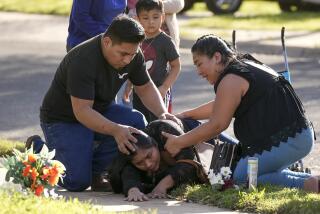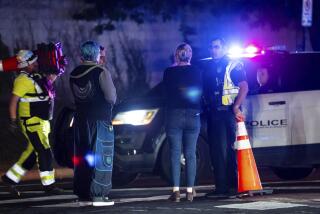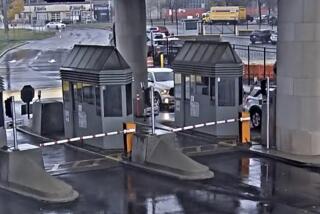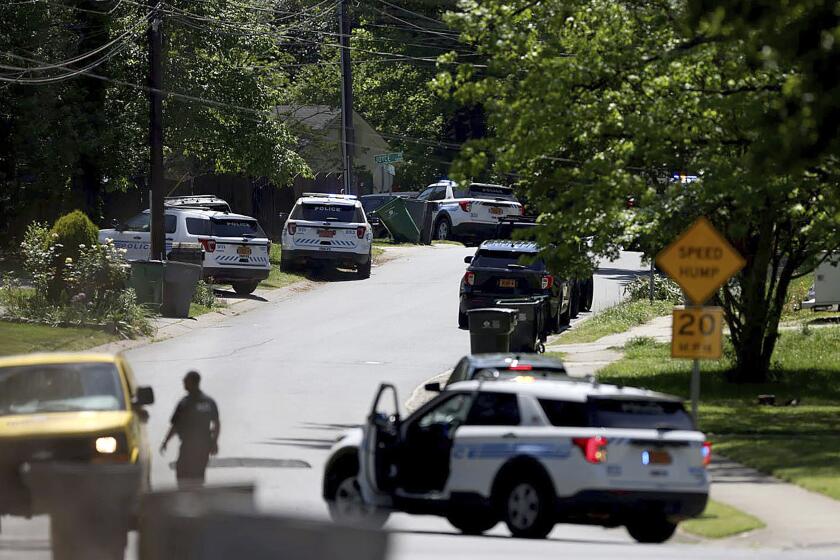McVeigh Viewed as ‘a Driving Force’ in Six-Month Plot : Bombing: Investigators now reject notion that he was just a follower. Officials believe attack was motivated by hatred of the government and bankrolled by robberies.
Investigators are becoming convinced that the Oklahoma City bombing grew out of a conspiracy lasting more than six months and that Timothy J. McVeigh was “a driving force” financed by a series of robberies, sources close to the case said Wednesday.
They also firmly believe that the attack was motivated by hatred of the U.S. government and that the 1993 assault on the Branch Davidian compound near Waco, Tex., served as “the flash point,” in the words of one official.
After Tuesday’s crushing setback for investigators, in which the FBI questioned and released two men after concluding that they had no connection to the bombing, agents now are concentrating on traditional detective work. They are interviewing everyone known to have been called by McVeigh and his Army friend Terry L. Nichols, who is being held as a material witness in the case. And they are trying to pinpoint the location of several purchases of ammonium nitrate, a major component of the explosive device.
In other developments Wednesday, McVeigh, in his first words from jail, issued a statement saying that he does not want to be represented by two criminal defense attorneys from Houston who some believe are trying to elbow into the high-profile case.
And recovery workers at the crumbling remains of the Alfred P. Murrah Federal Building here predicted that their efforts to find victims and clear out debris could be completed as early as Friday. By Wednesday evening, 144 were confirmed dead and 33 people were believed still missing. More than 400 were injured.
Federal investigators pored over several tons of rubble excavated from the explosion site and are casting new nets in search of the elusive “John Doe No. 2”--a tanned, muscular man believed to have helped put the bomb in place on April 19.
“There’s nobody high on the list--no No. 2 du jour,” one official said.
Investigators are “hammering hard on the phone records of McVeigh and Terry Nichols, identifying each and every phone call they made to individuals and businesses” over a period of months, a source said. Agents ask those who were were called about their conversations, seeking to add to the record they are building of the activities of McVeigh and Nichols.
One source close to the case said “it’s becoming more viable” that McVeigh was at least a “driving force” in the bombing. “He had the capacity and the anger,” the source said. McVeigh, 27, is the only person charged directly with the bombing.
The source said that investigators are discounting suggestions that McVeigh was only a follower or had been duped into his alleged actions by a larger group of conspirators.
Focusing on evidence that McVeigh had no known source of income for much of the period before the bombing, investigators are “pushing hard” to determine whether he and others might have been involved in criminal activities to finance the attack.
Agents are looking into 13 unsolved bank robberies in Nebraska, Iowa, Ohio, Missouri, Wisconsin and Kansas to try to find links to McVeigh or others. Also, one source said, “it’s highly probable they’re involved in other robberies, including commercial and home invasions.” He declined to provide any details but emphasized that he was not talking about “street stickups.”
So far, the search for other criminal activities has concentrated in the Midwest but it will be extended to the Kingman, Ariz., area, where McVeigh lived and where investigators believe that the planning for the bombing may have occurred.
The estimate that the alleged bombing conspiracy was planned for at least six months stems from receipts of ammonium nitrate purchases that investigators have linked to McVeigh and Nichols, although the purchaser or purchasers used aliases. One receipt, found in Nichols’ home in Herington, Kan., but with McVeigh’s fingerprints on it, is for a ton of the fertilizer substance and dates back to last fall, one source said.
Other receipts from a store in McPherson, Kan., have also been located, according to the source. He would not identify the store or specify the amounts purchased. The bomb is estimated by the federal Bureau of Alcohol, Tobacco and Firearms to have weighed about 4,800 pounds.
While agents believe that they have more evidence of Nichols’ possible involvement in a bombing conspiracy, they also suspect that his brother, James D. Nichols of Decker, Mich., also played a role. But the agents said that James Nichols is not believed to have been near the bomb site on the day of the explosion or just before it.
James Nichols also is being held as a material witnesses in the bombing. The brothers also are charged with making explosive devices and conspiring in those actions with McVeigh--although those alleged acts have not been linked to the bombing.
Weldon Kennedy, an FBI special agent in charge who is spearheading the investigation in Oklahoma City, suggested that the inquiry is far from over.
“We are now regarding this as a long-term investigation,” he said this week. “To bring all the necessary parts of this case together and prepare it for prosecution will certainly take months and months.”
In another development, Jim Rosencrans, 28, a Kingman, Ariz., man who said that he has been close friends with McVeigh for about two years, called The Times from the Mohave County Jail in Kingman. Rosencrans said that McVeigh told him in February that he was planning to take action against the government to “make a change.”
“He said: ‘Things have got to change.’ I said: ‘Yeah man, there’s no doubt in my mind, that they do. . . .’
“He just told me he’s got to do what he’s got to do. I told him he was crazy. I said if you are going to do it, happy trails. . . . I didn’t know that it meant blowing up a building.”
Rosencrans said that when he heard about the Oklahoma explosion, he knew immediately that McVeigh was involved. “When I saw it on TV, I said, ‘Damn, our boy has been bu” he said.
Rosencrans--who said he met McVeigh through Mike Fortier, an Army buddy of the bombing suspect--was arrested Monday night for disorderly conduct after he allegedly came out of his trailer carrying two rifles and with a pistol strapped to his hip while federal agents were searching the house of Fortier, his next-door neighbor. He told the agents he was going coyote hunting.
McVeigh is “good people, he’s righteous,” Rosencrans said. “It’s too bad things couldn’t be different. It’s too bad people have got to pay a high price. For freedom, there is a lot of patriot blood spilled. It’s a high price, it’s got to be paid. . . . He’s not a criminal.”
In Oklahoma City, the bomb crater is not yet fully explored. Agents continued to take large quantities of debris from the crater to other areas for examination.
“There were several tons,” Kennedy said. “I believe they brought in many, many loads of gravel to fill the hole after the excavation is complete. It’s several tons of material out of that hole.”
Oklahoma City Police Chief Sam Gonzales said that investigators remain confident that the case will be solved and that the focus now remains on finding Doe No. 2.
“I think too many people saw him when the Ryder truck was rented,” the chief said. “So I think John Doe No. 2 does exist.”
The accomplice was seen with McVeigh at the Junction City, Kan., truck rental agency, although investigators believe that McVeigh made the arrangements for the van.
McVeigh’s legal counsel has been an issue since his two Oklahoma City court-appointed attorneys, John W. Coyle III and Susan M. Otto, asked to be removed from the case because they had lost friends in the blast. Federal Magistrate Ronald Howland has denied their request and Coyle and Otto are appealing his decision.
At a pretrial hearing April 27 at the federal prison in El Reno, Okla., Howland described Houston attorneys Paul Looney and Brent Liedtke as “possibly privately retained counsel for the defendant.”
At the hearing, Looney told Howland that Coyle and Otto should continue to serve as temporary attorneys. “I believe it’s in the best interest of the defendant to go forward with the team at the table,” he said.
But Wednesday, McVeigh filed a federal “advisement to the court” stating that he did not want to be represented by Looney or Liedtke.
“I met with Messrs. Looney and Liedtke briefly during the morning of April 27 and I advised them that I did not desire their representation,” McVeigh said in his affidavit.
At the building recovery site, crews have stopped working at night because of the danger of shifting debris and the number of workers in the rubble at any time has shrunk to 15.
Serrano reported from Oklahoma City and Ostrow from Washington. Times staff writer Tina Daunt contributed from Los Angeles.
* RELATED STORIES, GRAPHIC: A18-A19
More to Read
Start your day right
Sign up for Essential California for news, features and recommendations from the L.A. Times and beyond in your inbox six days a week.
You may occasionally receive promotional content from the Los Angeles Times.







